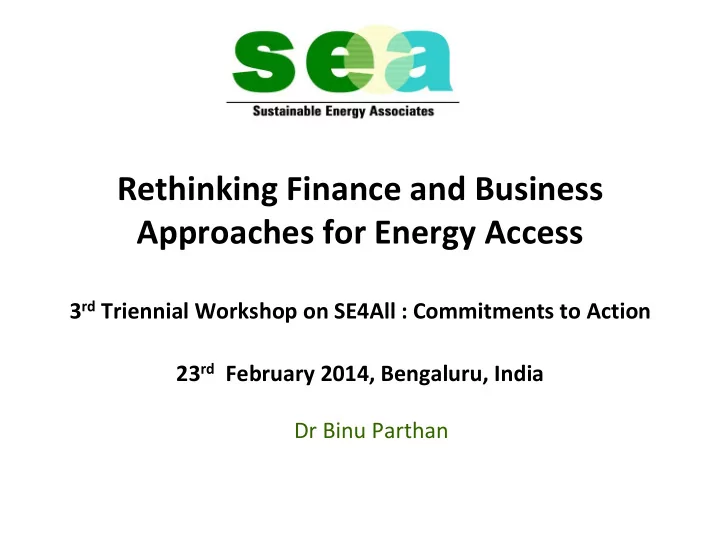

Rethinking Finance and Business Approaches for Energy Access 3 rd Triennial Workshop on SE4All : Commitments to Action 23 rd February 2014, Bengaluru, India Dr Binu Parthan
Energy Access Landscape 1.3 billion (17%) lack electricity access and 2.6 billion (41%) lack access to modern thermal energy; 2030 – 0.96 B no electricity access and 2.5 B no modern thermal energy!! Two regions – Sub-saharan Africa & South Asia, Also East Asia. Electricity access – 20 countries 2/3 rd (0.9 billion) – India, Nigeria, Bangladesh, Ethiopia, DRC… Modern thermal energy access – 20 countries – 20 countries 4/5 th (2.4 billion) – India, China, Bangladesh, Indonesia, Nigeria… 207 million people in Urban areas without electricity access. 2
Traditional Energy Access Business Model Energy Utility driven grid extension; RE Systems and devices – SHS, Solar Lanterns, cookstoves provided by government/donor; Community operated mini-grids – hydro, biomass. Commercial fuel distribution networks – Kerosene, LPG; Emphasis on household electrification Baseline – kerosene lamps, traditional cookstoves, diesel gen-sets etc. 3
Traditional Financing Frameworks Financing electricity network expansion, household electricity – Government/donor grants to energy utility; Capital subsidies to users for – household/individual owned systems - SHS, PV lanterns, cookstoves, biogas Capital subsidies for community based MHPs, Biomass power; Loans – low-interest/soft loans – utilities, user groups – co-operatives, Micro-credit – households/users; Fuel subsidies – LPG, Kerosene - $ 544 B globally 4
Challenges with traditional approach Financing infrastructure and not service delivery; Focus on electricity and lighting and households; Subsidy on fuels – energy inefficiency, misplaced; Economic activities – productivity opportunities of agriculture, rural commerce and industry not addressed. Public sector led, private sector role limited – suppliers; Equipment/systems subsidy – price distortions. 5
Challenges with Traditional Models (Contd.) Technology driven – donors and governments; Long-term low-return financial models; Long term – failures, low- quality service – black-outs brown outs; Government & donor resources finite – need more sustainable finance; Thermal energy challenges often not addressed. 6
New Thinking on Energy Access Business and Finance Technology neutral , Hybrids; Integrate thermal energy - ; 50-60% of energy for economic and social activities – use anchor customers; Larger scale – Mini-grids + thermal energy; Finance Energy Service Arrangements – softer loans for infrastructure, Policy & Regulatory framework for subsidising minimum energy consumption – cross-subsidy, RPOs. (Source: Lv Fang) Incentive framework for service delivery; 7
Emerging Thinking in Energy Access Use private sector for service delivery – PPP or 5P models; Tap into more sustainable finance – Local finance, TRECs, RPOs, remittances, carbon finance , crowdfunding, cryptocurrency- but use donor funds to de-risk innovative finance Piggyback on mobile telephony – coverage, transaction costs – mMoney/eWallet; 8
Some Progressive Business Frameworks LEAP - Lesotho Mini-grid concessions – reverse bidding PPPs; Technology neutral; Soft loans, financing mechanism for incentives, regulatory framework; ASERD - Afghanistan PPPs, Mini-grids, public and private service providers; Pre-paid meters, progressive purchase 50+ economic activity+ schools, health centres, places of worship; STEPs – Kenya, Lesotho, Malawi Thermal energy, service delivery, PPPs, Tech neutral 9
More Business Frameworks NuRa – South Africa Solar + LPG, Energy Centres, regulatory framework. PAYG – East and South Africa, India Econet Solar, Angaza, Azuri, M-Kopa, Simpa; Solar Lighting, daily small payments – kerosene avoidance; Thermal energy contracts- Sub- saharan Africa, Inyenyeri, ACE, Vagga til Vagga; Stove+Briquettes , fuel contracts – money/barter; 10
Sustainable Financing Beyond donors and governments; Carbon finance – CERs but VERS GS – Cookstoves, solar energy programmes – 6-10$/tCO 2 e; Migrant remittances – Crowdfunding – low cost finance, grants, SunFunder, Mosaic, Abundance, Solarschools. Cryptocurrency – SolarCoin – 1= 1MWh -20-30 $ Regulation – cross-subsidy; RPOs; TRECS; 11
Final thoughts Achieving universal access by needs higher scale resources – $ 100 m/year to $49.5 b -$86 b/year; Current efforts – public sector driven larger scale – Pvt initiatives – small scale; Technology neutrality, service orientation, private sector role; Innovative financing and business models – Partnerships, for Universal Access by 2030. 12
Thank You All pictures from Sustainable Energy Associates info@seassoc.org 13
Recommend
More recommend